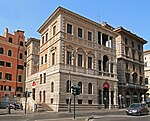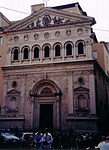Baths of Agrippa
Ancient Roman baths in RomeAugustan building projectsBuildings and structures completed in the 1st century BCHadrianic building projectsMarcus Vipsanius Agrippa

The Baths of Agrippa (Latin: Thermae Agrippae) was a structure of ancient Rome, in what is now Italy, built by Marcus Vipsanius Agrippa. It was the first of the great thermae constructed in the city, and also the first public bath.
Excerpt from the Wikipedia article Baths of Agrippa (License: CC BY-SA 3.0, Authors, Images).Baths of Agrippa
Via dell'Arco della Ciambella, Rome Municipio Roma I
Geographical coordinates (GPS) Address External links Nearby Places Show on map
Geographical coordinates (GPS)
| Latitude | Longitude |
|---|---|
| N 41.896905555556 ° | E 12.476997222222 ° |
Address
Terme di Agrippa
Via dell'Arco della Ciambella
00186 Rome, Municipio Roma I
Lazio, Italy
Open on Google Maps










